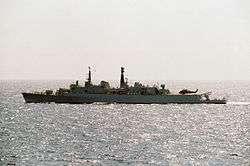HMS Antrim (D18)
 Chilean destroyer Cochrane | |
| History | |
|---|---|
| Name: | HMS Antrim |
| Namesake: | Antrim |
| Ordered: | 5 January 1965 |
| Builder: | Upper Clyde Shipbuilders |
| Laid down: | 20 January 1966 |
| Launched: | 19 October 1967 |
| Sponsored by: | Mrs Roy Mason, wife of then Minister of Defence (Equipment), Roy Mason |
| Commissioned: | 14 July 1970 |
| Decommissioned: | 1984 |
| Identification: | pennant number: D18 |
| Honours and awards: | Falklands War |
| Fate: | Sold to Chile on 22 June 1984 |
| Name: | Almirante Cochrane |
| Namesake: | Thomas Cochrane |
| Acquired: | 22 June 1984 |
| Decommissioned: | 7 December 2006 |
| General characteristics | |
| Class and type: | County-class destroyer |
| Displacement: | 5,440 tonnes (6,850 tonnes full load) |
| Length: | 522 ft (159 m) |
| Beam: | 53 ft (16 m) |
| Draught: | 20 ft (6.1 m) |
| Propulsion: | COSAG (Combined steam and gas) turbines, 2 shafts |
| Armament: |
|
| Aircraft carried: | 1 × Wessex HAS Mk 3 helicopter Humphrey |
| Aviation facilities: | Flight deck and enclosed hangar for embarking one helicopter |
HMS Antrim was a County-class destroyer of the British Royal Navy launched on 19 October 1967. In the Falklands War, she was the flagship for the recovery of South Georgia, participating in the first ever anti-submarine operation successfully conducted exclusively by helicopters. In 1984, she was commissioned into the Chilean Navy, and renamed Almirante Cochrane.
Background
Antrim first commissioned in 1970 and served her first commission in home and Mediterranean waters.[1] In the mid-1970s, the Royal Navy removed 'B' turret and replaced it with four Exocet missile launchers to give her a much more powerful anti-ship capability.
Operational history
In 1976 her commission included a visit to Stockholm where she represented the Royal Navy at the wedding of the King of Sweden.[2]
Falklands War
In 1982 she formed part of the Royal Navy task force for service in the Falklands War.
Antrim was the flagship of Operation Paraquet, the recovery of South Georgia in April 1982,[3] where she took part in a 400 shell bombardment.[4] Her helicopter, a Westland Wessex HAS.Mk3, was responsible for the rescue of 16 SAS men from Fortuna Glacier, and the crew of two previous rescue helicopters that had crashed. The aircraft played a key role in the detection and disabling of the Argentinian submarine Santa Fe.[4] This was the first ever anti-submarine operation successfully conducted exclusively by helicopters.[5] Captain Largos, commander of the Argentine forces on South Georgia, signed the surrender document for the Argentine Forces there in her wardroom. Lieutenant-Commander Alfredo Astiz signed a separate document shortly afterwards aboard HMS Plymouth.
While supporting the main landing at San Carlos Water, 12 bombs narrowly missed, but a 1,000 lb (450 kg) bomb penetrated Antrim. It did not explode or kill anyone, and it took 10 hours to remove.[4] Antrim fired her Sea Slug Missile at an Argentine Air Force A-4 Skyhawk without hitting it.
A name board formerly belonging to her now resides in the Falkland Islands Museum, Stanley.[6]

Chilean Navy
Antrim was decommissioned in 1984 and sold to Chile on 22 June 1984. The Chileans renamed her Almirante Cochrane after Thomas Cochrane, who had commanded the Chilean Navy from 1817 to 1822. In 1994, Almirante Cochrane underwent the same refit as her sister ship Blanco Encalada. This entailed removing her Sea Slug launcher and extending her deck aft to allow the installation of a new, larger hangar. In 1996 she received the Barak SAM in place of her Seacat launchers.
The Chilean Navy decommissioned Almirante Cochrane on 7 December 2006. On 11 December 2010, she was towed to China for scrap.
Affiliates as HMS Antrim
As part of her relationship with County Antrim, she carried a piece of the Giant's Causeway mounted in the ship's main passageway, appropriately also named the Giant's Causeway.[8]
Commanding officers
| From | To | Captain |
|---|---|---|
| 1970 | 1971 | Captain H W E Hollins RN |
| 1971 | 1973 | Captain D A Loram MVO RN |
| 1973 | 1974 | Captain George A F Bower RN |
| 1974 | 1975 | Captain Harry R Keate RN |
| 1975 | 1977 | Captain R Michael Burgoyne RN |
| 1977 | 1979 | Captain Gordon F Walwyn RN |
| 1979 | 1981 | Captain Michael F Parry RN |
| 1981 | 1983 | Captain B G Young DSO RN |
| 1983 | 1984 | Captain Jake D L Backus RN |
Notes
- ↑ http://www.axfordsabode.org.uk/pdf-docs/antrim03.pdf
- ↑ http://www.axfordsabode.org.uk/pdf-docs/antrim01.pdf
- ↑ http://www.axfordsabode.org.uk/pdf-docs/antrim09.pdf
- ↑ "Captain Brian Young obituary". Telegraph. 12 January 2010.
- ↑ HMS Gloucester delivers Task Force South exhibit to Falklands Museum
- ↑ HMS Antrim and the Royal Irish Rangers
- ↑ Navy News - Fact Card - HMS Antrim
Sources
- Colledge, J. J.; Warlow, Ben (2006) [1969]. Ships of the Royal Navy: The Complete Record of all Fighting Ships of the Royal Navy (Rev. ed.). London: Chatham Publishing. ISBN 978-1-86176-281-8. OCLC 67375475.
- McCart, Neil, 2014. County Class Guided Missile Destroyers, Maritime Books. ISBN 978-1904459637
- Yates, D. (2006) Bomb Alley - Falklands War 1982: Aboard HMS Antrim at War, Pen & Sword Maritime, ISBN 1-84415-417-3
- Parry, Chris (2012) "Down South: a Falklands War Diary" Viking Penguin ISBN 978-0-670-92145-4